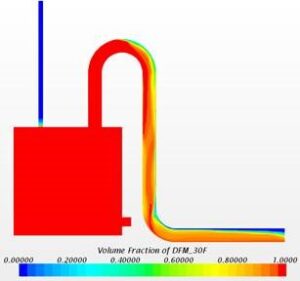News & Events

By: Anthony DeFilippo, P.E.
The purpose of this study is to determine if siphonic effects are able to induce a pressure recovery in ship tank overflow piping in favorable flow conditions. The study will go over key features and flow parameters that will likely produce the siphonic effects and the potential that this knowledge imparts for the design of tank overflow arrangements.
Overflow piping is necessary when filling tanks on a large scale since allowing a closed tank to fill past its capacity will likely exceed its design strength resulting in failure. Investigating if a pressure recovery credit can be taken to minimize or negate the effects of frictional losses can have a positive effect to optimize tank and piping design. An optimized design can reduce cost and weight.
The methods implemented in this study include the use of a Pressure Drop Worksheet which uses the Darcy-Weisbach equation for friction loss through a pipe, a computational fluid dynamics simulation program (Star-CCM+), and a fluid flow analysis and design modeling software (Pipe-Flo Professional). Using these three tools, the effects of siphons on pressure drop can be compared across different flowrates. A baseline will be established in order to ensure that each tool will provide a similar result in a simplified scenario. Star-CCM+ and Pipe-Flo Professional will be tested to ensure that a siphon can actually be modeled within the program. A pressure drop vs. flowrate comparison between the three tools will be established. Future work can be performed to determine how upstream and downstream conditions will affect the magnitude of the siphon.

Figure 16: CFD Volume Fraction at 200 GPM
To learn more about Pressure Recovery in Overflow Piping Due to Siphonic Effects please reach out to Anthony DeFilippo at adefilippo@gibbscox.com.
Reproduced with permission from the American Society of Naval Engineers.
